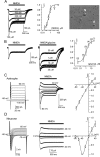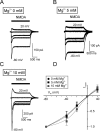NMDA receptors mediate neuron-to-glia signaling in mouse cortical astrocytes
- PMID: 16525046
- PMCID: PMC6675155
- DOI: 10.1523/JNEUROSCI.4689-05.2006
NMDA receptors mediate neuron-to-glia signaling in mouse cortical astrocytes
Abstract
Chemical transmission between neurons and glial cells is an important element of integration in the CNS. Here, we describe currents activated by NMDA in cortical astrocytes, identified in transgenic mice that express enhanced green fluorescent protein under control of the human glial fibrillary acidic protein promoter. Astrocytes were studied by whole-cell voltage clamp either in slices or after gentle nonenzymatic mechanical dissociation. Acutely isolated astrocytes showed a three-component response to glutamate. The initial rapid component was blocked by 1,2,3,4-tetrahydro-6-nitro-2,3-dioxo-benzo[f]quinoxaline-7-sulfonamide (NBQX), which is an antagonist of AMPA receptors (IC50, 2 microM), and the NMDA receptor antagonist D-AP-5 blocked the later sustained component (IC50, 0.6 microM). The third component of glutamate application response was sensitive to D,L-threo-beta-benzyloxyaspartate, a glutamate transporter blocker. Fast application of NMDA evoked concentration-dependent inward currents (EC50, 0.3 microM); these showed use-dependent block by (+)-5-methyl-10,11-dihydro-5H-dibenzo [a,d] cyclohepten-5,10-imine maleate (MK-801). These NMDA-evoked currents were linearly dependent on membrane potential and were not affected by extracellular magnesium at concentrations up to 10 mM. Electrical stimulation of axons in layer IV-VI induced a complex inward current in astrocytes situated in the cortical layer II, part of which was sensitive to MK-801 at holding potential -80 mV and was not affected by the AMPA glutamate receptor antagonist NBQX. The fast miniature spontaneous currents were observed in cortical astrocytes in slices as well. These currents exhibited both AMPA and NMDA receptor-mediated components. We conclude that cortical astrocytes express functional NMDA receptors that are devoid of Mg2+ block, and these receptors are involved in neuronal-glial signal transmission.
Figures









Similar articles
-
Role of neuronal NR2B subunit-containing NMDA receptor-mediated Ca2+ influx and astrocytic activation in cultured mouse cortical neurons and astrocytes.Synapse. 2006 Jan;59(1):10-7. doi: 10.1002/syn.20213. Synapse. 2006. PMID: 16235228
-
Effects of competitive NMDA receptor antagonists on excitatory amino acid-evoked currents in mouse spinal cord neurones.Fundam Clin Pharmacol. 1999;13(1):67-74. doi: 10.1111/j.1472-8206.1999.tb00322.x. Fundam Clin Pharmacol. 1999. PMID: 10027090
-
Distinct pharmacological and functional properties of NMDA receptors in mouse cortical astrocytes.Br J Pharmacol. 2011 Aug;163(8):1755-66. doi: 10.1111/j.1476-5381.2011.01374.x. Br J Pharmacol. 2011. PMID: 21449975 Free PMC article.
-
Bidirectional astrocyte-neuron communication: the many roles of glutamate and ATP.Novartis Found Symp. 2006;276:208-17; discussion 217-21, 233-7, 275-81. doi: 10.1002/9780470032244.ch16. Novartis Found Symp. 2006. PMID: 16805432 Review.
-
NMDA Receptors in Astrocytes.Neurochem Res. 2020 Jan;45(1):122-133. doi: 10.1007/s11064-019-02750-3. Epub 2019 Feb 14. Neurochem Res. 2020. PMID: 30767094 Review.
Cited by
-
Neurotransmitters and integration in neuronal-astroglial networks.Neurochem Res. 2012 Nov;37(11):2326-38. doi: 10.1007/s11064-012-0765-6. Epub 2012 Apr 3. Neurochem Res. 2012. PMID: 22476701 Review.
-
Synaptogenesis by Cholinergic Stimulation of Astrocytes.Res Sq [Preprint]. 2023 Feb 13:rs.3.rs-2566078. doi: 10.21203/rs.3.rs-2566078/v1. Res Sq. 2023. Update in: Neurochem Res. 2023 Oct;48(10):3212-3227. doi: 10.1007/s11064-023-03979-9. PMID: 36824819 Free PMC article. Updated. Preprint.
-
Plasma amino acids changes in complex regional pain syndrome.Pain Res Treat. 2013;2013:742407. doi: 10.1155/2013/742407. Epub 2013 Nov 4. Pain Res Treat. 2013. PMID: 24303215 Free PMC article.
-
P2X1 and P2X5 subunits form the functional P2X receptor in mouse cortical astrocytes.J Neurosci. 2008 May 21;28(21):5473-80. doi: 10.1523/JNEUROSCI.1149-08.2008. J Neurosci. 2008. PMID: 18495881 Free PMC article.
-
GABAergic neurotransmission and new strategies of neuromodulation to compensate synaptic dysfunction in early stages of Alzheimer's disease.Front Cell Neurosci. 2014 Jun 25;8:167. doi: 10.3389/fncel.2014.00167. eCollection 2014. Front Cell Neurosci. 2014. PMID: 24987334 Free PMC article. Review.
References
-
- Akaike N, Moorhouse AJ (2003). Techniques: applications of the nerve-bouton preparation in neuropharmacology. Trends Pharmacol Sci 24:44–47. - PubMed
-
- Akopian G, Kuprijanova E, Kressin K, Steinhuser C (1997). Analysis of ion channel expression by astrocytes in red nucleus brain stem slices of the rat. Glia 19:234–246. - PubMed
-
- Araque A, Carmignoto G, Haydon PG (2001). Dynamic signaling between astrocytes and neurons. Annu Rev Physiol 63:795–813. - PubMed
Publication types
MeSH terms
Substances
Grants and funding
LinkOut - more resources
Full Text Sources
Other Literature Sources
